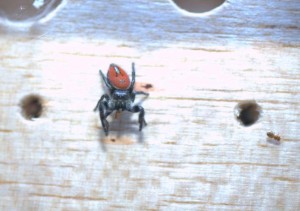One giant leap for spiderkind – a lot of leaps, actually
The universe’s most well-traveled spider, a Phidippus johnsoni with the grand name of Nefertiti, died recently in what was supposed to be her quiet retirement home. Reporters made much of how this chunky, red-and-black jumper not only thrived in her 100 days aboard the International Space Station but withstood the rigors of launch, re-entry, and being shuttled about the country with apparent good grace. Nefertiti seems to have reached the end of her brief natural lifespan in the warm confines of an exhibit at the Smithsonian’s National Museum of Natural History.
Spiders have the right stuff, forgive me trotting out that phrase. They’re focused, efficient, and as taciturn as any Neil Armstrong. This particular arachnaut, a regular Sally Ride, had a simple mission that she performed with grace and energy: catching flies. And the wondrous thing: she did it in zero gravity, an environment no earthly spider could be expected to grasp. Think of those millions of years of earthbound instincts, honed to an unimagineable degree … and yet this jumping spider was all feh, I can do this—I’ll just adjust the trajectory here and the thrust there, disregard millennia of sensory input, and boom: bug soup.
I don’t think any old spider could have done it. Jumping spiders are the brains of the outfit. Equipped with sophisticated, unblinking, networked cameras around their little heads, they see and hunt famously well. They’ve been observed sneaking up on prey that they can’t even see, calculating how to creep up under cover and burst out at just the right instant. It would be like you stalking a pizza delivery guy walking along on the other side of a tall fence, figuring out when he’s going to stop and tie his shoe or check his text messages, pursuing him around the corner, and then out you pop through a loose board and snatch his pie. Yep, it takes thought.
Nefertiti got her ticket to ride thanks to an 18-year-old Egyptian named Amr Mohamed, who won the YouTube Spacelab contest with his idea for a jumping-spider experiment. (There was a second arachnaut, a zebra-striped Salticus scenicus named Cleopatra, but alas, she died in orbit.) Once aloft, astronaut Suni Williams took the spiders under her wing and blogged about them. She remarked about Nefertiti: “She is sort of scary. I am so glad I am not a fruit fly. I opened up the habitat and actually saw her running around at full speed looking for something to eat. It was difficult to even get a steady picture.”
Watch her do it. It’s funny how earthlike it looks. She does that classic Salticid prowl, but I think she’s hanging on to the surface a bit more consciously, as astronauts do. Can’t see it, but surely she’s letting out a silk dragline before the leap to reel herself back in if she misses. But jumping spiders always do that on earth, too.
Nefertiti was not the first spider in space. Experiments involving zero-G web building by spiders also took place aboard Skylab (that’s old-school space program, kiddies), on the space station twice before, and on the shuttle Columbia. Australian high-school students designed Columbia’s science module to see whether eight garden-variety orb spiders could do their weaving and hunting jobs in space. Those spiders perished when Columbia was destroyed during re-entry in 2003.
Until recently, a brave little website by the Glen Waverley Secondary College devoted to that aborted spider experiment was still archived on the web, drifting forlornly through cyberspace. The tab labeled “Results” was blank.
But there’s more to that story, and not really about spiders but about science and humans. Most of the spider data was lost along with the shuttle and its crew, but spacecraft did fly again. The teenagers who planned that experiment with such care resolved to let their work stand as homage to the people who venture into space. There will be other experiments, schoolchildren will dream them up, and other lives long and short will be entwined into the struggle to find Big Picture answers in the warm earth and the cold silence of space.
In 2011 two golden orb-weaving spiders preceded Nefertiti on the International Space Station, delivered via shuttle Endeavour in its last flight, and put in more than two months in another web-building experiment. Only one survived the return trip, and it obliquely offered aspiring scientists and teachers a lesson in humility.
Details matter in science and spaceflight, often to a poignant degree. The students, amid their extremely detailed preparations, had named this arachnaut Gladys. Back on earth, she was determined to be a he.
Henceforth the returned traveler was called Gladstone.

